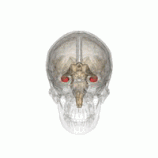Neurotrophic hypothesis of depression
The neurotrophic hypothesis of depression[1] proposes that major depressive disorder (MDD) is caused, at least partly, by impaired neurotrophic support. Neurotrophic factors (also known as neurotrophins) are a family of closely related proteins which regulate the survival, development, and function of neurons in both the central and peripheral nervous systems.
Inadequacy of the monoamine hypothesis of depression
[edit]
The monoamine hypothesis of depression suggests that depression is primarily caused by a deficiency of several monoamines, namely serotonin, dopamine and norepinephrine.[2] This hypothesis is widely accepted due to its simplicity.[3] However, the monoamine hypothesis of depression is considered incomplete, as several lines of evidence suggest that a monoamine deficiency cannot be the sole cause of depression. For example, antidepressants usually take several weeks to exert a noticeable effect, which is inconsistent with the fact that monoamine levels start to increase within hours of using antidepressants.[4] This suggests that antidepressants need to influence other biological systems, apart from monoamines, to improve a patient's mental health.
The role of BDNF in depression
[edit]Brain-derived neurotrophic factor (BDNF) is a neurotrophin that is vital to the survival, growth, and maintenance of neurons in key brain circuits involved in emotional and cognitive function.[5] BDNF has been studied more than other neurotrophic factors for its potential role in depression. Altered BDNF function and levels are implicated in depression, as suggested by several lines of evidence.
Depression is associated with a decrease in hippocampal volume due to neuronal atrophy. Decreased levels of BDNF in the hippocampus may contribute to this neuronal atrophy.[4] In contrast, increased BDNF levels in the hippocampus may enhance neurogenesis, neuronal cell survival and dendritic branching.[4]
Suicide victims have been found to have decreased levels of:[4]
- BDNF mRNA and BDNF proteins
- TrkB (receptor for BDNF)
- CREB (transcription factor which activates BDNF)

Individuals with the BDNF Val66Met polymorphism have been found to have decreased hippocampal volume.
Individuals with the BDNF Val66Met polymorphism are more susceptible to depression, anxiety and bipolar disorder.[4] Furthermore, people with these gene have been found to have decreased hippocampal volume, which is a common structural change associated with depression. This genes results in decreased activity-dependent secretion of BDNF.
In humans, BDNF increase has been reported for the following classes of antidepressants:[6]
- Selective serotonin reuptake inhibitors
- Norepinephrine reuptake inhibitors
- Serotonin norepinephrine reuptake inhibitors
- Monoamine oxidase inhibitors
- Atypical antidepressants
Relationship of the neurotrophic hypothesis of depression to other theories
[edit]The neurotrophic hypothesis of depression is closely related to the neuroplasticity and neurogenesis hypotheses of depression, as both the processes of neuroplasticity and neurogenesis are affected by neurotrophic factors.
See also
[edit]- Neurotrophic factors
- Brain derived neurotrophic factor
- Neuroplasticity
- Neurogenesis
- Neurogenesis hypothesis of depression
References
[edit]- ^ Duman, Ronald S.; Li, Nanxin (2012-09-05). "A neurotrophic hypothesis of depression: role of synaptogenesis in the actions of NMDA receptor antagonists". Philosophical Transactions of the Royal Society B: Biological Sciences. 367 (1601): 2475–2484. doi:10.1098/rstb.2011.0357. ISSN 0962-8436. PMC 3405673. PMID 22826346.
- ^ Delgado, P. L. (2000). "Depression: the case for a monoamine deficiency". The Journal of Clinical Psychiatry. 61 (Suppl 6): 7–11. ISSN 0160-6689. PMID 10775018.
- ^ Boku, Shuken; Nakagawa, Shin; Toda, Hiroyuki; Hishimoto, Akitoyo (2018). "Neural basis of major depressive disorder: Beyond monoamine hypothesis: Neural basis of major depressive disorder". Psychiatry and Clinical Neurosciences. 72 (1): 3–12. doi:10.1111/pcn.12604. PMID 28926161. S2CID 12091197.
- ^ a b c d e Yu, Hui; Chen, Zhe-yu (2010-12-06). "The role of BDNF in depression on the basis of its location in the neural circuitry". Acta Pharmacologica Sinica. 32 (1): 3–11. doi:10.1038/aps.2010.184. ISSN 1671-4083. PMC 4003317. PMID 21131999.
- ^ Phillips, Cristy (2017). "Brain-Derived Neurotrophic Factor, Depression, and Physical Activity: Making the Neuroplastic Connection". Neural Plasticity. 2017: 1–17. doi:10.1155/2017/7260130. ISSN 2090-5904. PMC 5591905. PMID 28928987.
- ^ Neto, Fani L; Borges, Gisela; Torres-Sanchez, Sonia; Mico, Juan A; Berrocoso, Esther (2011). "Neurotrophins Role in Depression Neurobiology: A Review of Basic and Clinical Evidence". Current Neuropharmacology. 9 (4): 530–552. doi:10.2174/157015911798376262. ISSN 1570-159X. PMC 3263450. PMID 22654714.

